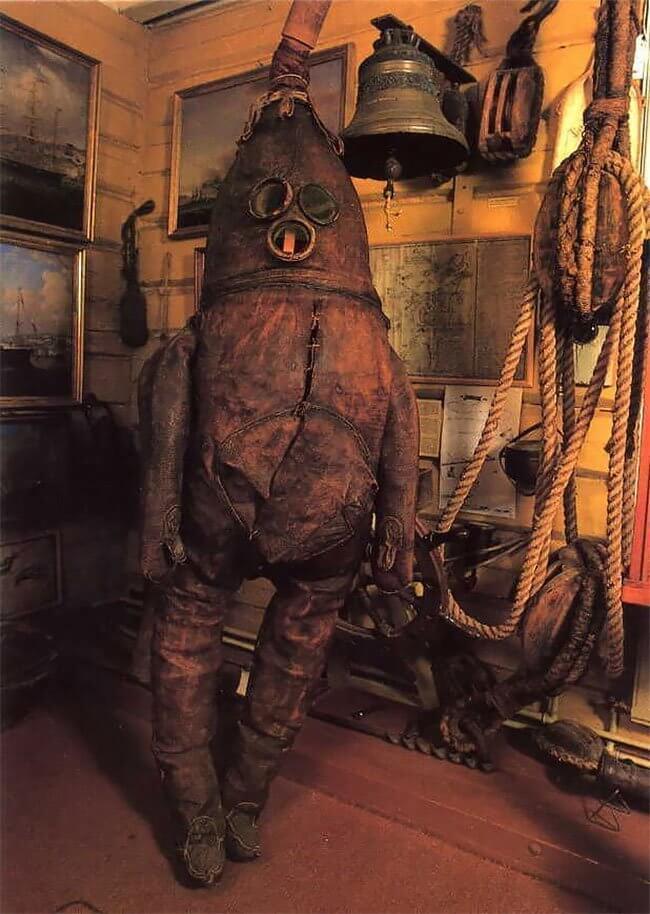Known as the earliest known diving suit, the Old Gentleman enabled divers to check the hulls of ships without having to drydock them.
One must admit that the suit doesn’t have an appealing look, yet the “Old Gentlemen of Raaha” truly fulfilled its purpose, which is to aid divers. It dates back to the early 18th century.
In the 1860s, a Finnnish shipowner and mariner called Captain Johan Leufstadius (1795-1867), gave away the suit to the Raahe Museum, the oldest local museum in Finland, situated on a busy shipping and shipbuilding centre on the Gulf of Bothnia during the 18th century.
Because the toes of the feet bear resemblance to the traditional Finnish boots, while the hands represent Finnish’s forester mittens, the suit itself is given credits to Finland.
Furthermore, an identical diving suit was depicted by a painting dating back to 1727, on display in the Swedish National Archive, helping to date the suit.
The suit is created mainly from leather, with seams stitched with pitch thread and sealed with pitch, which is derived from petroleum, coal tar, or plants. It was coated with a mixture of mutton tallow, tar, and pitch to be waterproof.
A wooden framework was used to reinforce the hood, preventing it from collapsing under water pressure. An opening for a wooden air pipe is at the peak of the hood. Air was pumped to the diver with a piston pump or a bellows, and discharged through a short pipe on the backside.
Divers sporting The Old Gentleman could only remain submerged for a short period of time, because it wasn’t totally watertight and couldn’t withstand high pressure.
A reproduction of The Old Gentleman was created in 1988, named The Young Gentleman, intentionally to check if The Old Gentleman could have operated in reality. The New Gentleman worked without any restrictions in diving depth or duration, able to be submerged for 40 minutes.
The Old Gentleman has made its way around the world. It was displayed in Philadelphia in the U.S., at London's Sea Finland exhibition in 1985, and at the 1998 World Exposition in Lisbon, Portugal. However, The Old Gentleman's traveling days are over, and today, it is The Young Gentleman that appears in exhibitions around the world.
VIDEO:
One must admit that the suit doesn’t have an appealing look, yet the “Old Gentlemen of Raaha” truly fulfilled its purpose, which is to aid divers. It dates back to the early 18th century.
In the 1860s, a Finnnish shipowner and mariner called Captain Johan Leufstadius (1795-1867), gave away the suit to the Raahe Museum, the oldest local museum in Finland, situated on a busy shipping and shipbuilding centre on the Gulf of Bothnia during the 18th century.
 Source: YouTube
Source: YouTube
Because the toes of the feet bear resemblance to the traditional Finnish boots, while the hands represent Finnish’s forester mittens, the suit itself is given credits to Finland.
Furthermore, an identical diving suit was depicted by a painting dating back to 1727, on display in the Swedish National Archive, helping to date the suit.
How it was made
The suit is created mainly from leather, with seams stitched with pitch thread and sealed with pitch, which is derived from petroleum, coal tar, or plants. It was coated with a mixture of mutton tallow, tar, and pitch to be waterproof.
 Source: YouTube
Source: YouTube
A wooden framework was used to reinforce the hood, preventing it from collapsing under water pressure. An opening for a wooden air pipe is at the peak of the hood. Air was pumped to the diver with a piston pump or a bellows, and discharged through a short pipe on the backside.
Divers sporting The Old Gentleman could only remain submerged for a short period of time, because it wasn’t totally watertight and couldn’t withstand high pressure.
A reproduction of The Old Gentleman was created in 1988, named The Young Gentleman, intentionally to check if The Old Gentleman could have operated in reality. The New Gentleman worked without any restrictions in diving depth or duration, able to be submerged for 40 minutes.
 Source: YouTube
Source: YouTube
The Old Gentleman has made its way around the world. It was displayed in Philadelphia in the U.S., at London's Sea Finland exhibition in 1985, and at the 1998 World Exposition in Lisbon, Portugal. However, The Old Gentleman's traveling days are over, and today, it is The Young Gentleman that appears in exhibitions around the world.
VIDEO: